Understanding GIA Pricing: A Guide to Gemstone Value

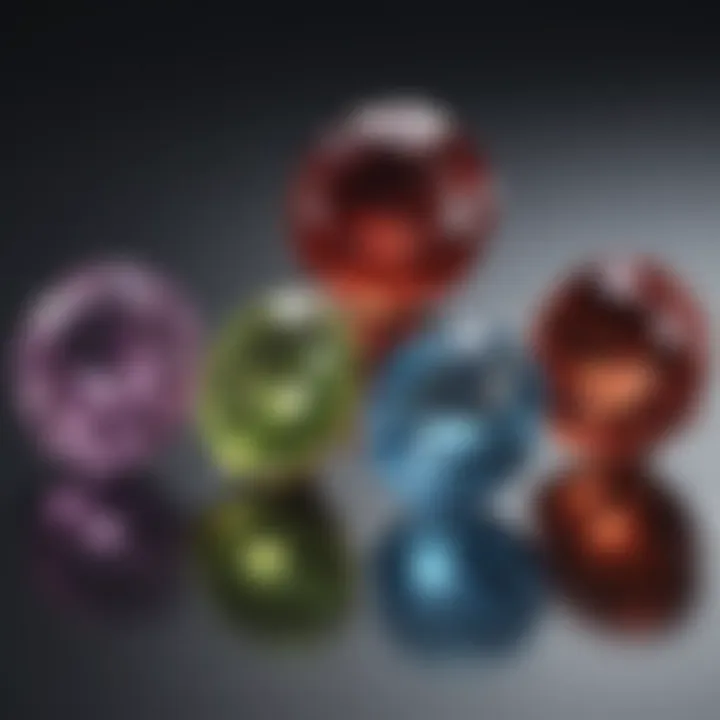
Intro
When it comes to investing in gemstones, there's a whole world of intricacies under the surface. Understanding the pricing framework established by the Gemological Institute of America, or GIA, is crucial for anyone who wishes to acquire valuable pieces, whether for personal use or commercial purposes. This article takes you through the essential elements that influence gemstone value, empowering you to make informed decisions in your purchases. The balance between art and science guides the GIA’s valuation process, predominantly hinging on the four Cs: carat, cut, color, and clarity. But that’s just the tip of the iceberg. We'll also look at the implications of market trends, the rarity of materials, and consumer behavior, allowing you to appreciate the multifaceted nature of gemstone valuation.
Gemstone Overview
Definition and Origins
Gemstones are naturally occurring minerals or rocks that are prized for their beauty, durability, and rarity. The term "gemstone" often implies polished and cut variations used in jewelry and ornamentation. Historically, these precious materials have fascinated civilizations across ages, originating from different geological environments. For instance, diamonds are formed under intense pressure deep within the Earth, while opals might develop within volcanic ash deposits. This complex journey before reaching the jewelry store adds a unique narrative to each gemstone.
Historical Significance
From the ancient Egyptians, who adorned their tombs with lapis lazuli, to the coronation crowns of European monarchs adorned with sapphires and rubies, gemstones have long played a role in cultures worldwide. They weren't merely adornments; they symbolized power, wealth, and even health. The historical significance of a gemstone can often add another layer to its value, as collectors frequently seek not just the stone itself but also the story it carries.
Gemstone Properties
Hardness and Durability
Gemstones vary significantly in terms of hardness, as measured by the Mohs scale. Diamonds, renowned as the hardest naturally occurring substance, lead that ranking at a perfect 10. On the other end, talc rates a mere one, making it unsuitable for most jewelry applications. Familiarity with a gemstone's hardness informs potential buyers about its durability and suitability for various settings.
Color and Clarity
Color and clarity are perhaps the most perceptible attributes that captivate enthusiasts and collectors. Color itself can be subjective, influenced by light conditions and surrounding hues. The GIA uses specific grading systems to categorize color across the spectrum, based not only on hue but saturation and tone.
Clarity, on the other hand, refers to the presence of inclusions or blemishes. A stone with higher clarity is generally more desirable. The GIA’s clarity grading scale ranges from Flawless to Included, with each category presenting distinct visual characteristics. Understanding these properties is essential for deciphering value and desirability in the gemstone market.
"The beauty of a gemstone shines brightest when its origins and qualities are fully understood."
As we navigate further through this article, we will delve deeper into how these properties articulate the broader narrative of gemstone valuation, alongside the ever-crucial market dynamics that investors must grasp. Stay tuned as we unwrap this captivating realm, shedding light on how both science and art converge in determining the worth of these precious stones.
Prologue to GIA Pricing
Understanding the GIA pricing system is paramount for anyone engaged with gemstones, from casual collectors to seasoned jewelers. The Gemological Institute of America, or GIA for short, is recognized as the gold standard when it comes to gemstone grading and certification. This significance cannot be overstated, as GIA’s methodologies not only set industry benchmarks but also instill buyer confidence.
When navigating the often murky waters of gemstone valuation, GIA serves as a beacon of clarity. Consumers and professionals alike rely on the GIA's pricing references to provide a sense of fairness and objectivity in the market. This structured approach means that buyers can make informed decisions, ensuring they are not left in the dark, chasing overpriced stones or dubious deals.
As we delve deeper into this article, several critical elements of GIA pricing will be scrutinized. We will focus on specifics, including the Four Cs—cut, color, carat, and clarity—each playing a vital role in determining value. Moreover, nuances such as market trends, rarity, and consumer behavior will be discussed, elucidating how they shape pricing.
The benefits of understanding GIA pricing extend beyond simply making a purchase. For instance, knowing which factors most contribute to a stone's value can empower buyers to negotiate effectively, spotting opportunity where others might see risk. Similarly, enthusiasts who appreciate gemstones from an aesthetic viewpoint can gain deeper insights into what makes certain stones desirable.
Ultimately, grasping the GIA pricing methodology helps demystify gemstone valuation. This understanding reveals why some stones command higher prices while others remain in the shadows. With this knowledge, both buyers and sellers can approach the market with confidence, ensuring their investments are sound.
"The GIA doesn’t just grade gems; it validates their worth, giving meaning to a stone beyond mere beauty."
In summary, the importance of GIA pricing in the gemstone world cannot be taken lightly. This robust framework not only guarantees transparency and integrity in sales but also enriches the collector's journey, transforming what might be a simple transaction into a calculated investment.
The Role of GIA in Gemstone Valuation
The significance of GIA, or the Gemological Institute of America, in gemstone valuation cannot be overstated. Founded in 1931, GIA is known worldwide for its rigorous grading systems and commitment to advancing the knowledge of gemology. The contributions of GIA to pricing and valuation extend beyond just numbers; they set a standard that is widely recognized and respected across the industry.
Essentially, GIA provides a framework that helps buyers, collectors, and sellers understand the true worth of gemstones. By adhering to GIA’s grading standards, stakeholders in the market can make informed decisions. This not only enhances transparency but also fosters confidence among consumers and industry professionals alike.
- Trust and Credibility: A GIA certificate substantially boosts a gem’s value because it assures buyers of its authenticity and quality. A stone without such certification can often find itself significantly undervalued, regardless of its intrinsic qualities.
- Market Influence: GIA’s grading becomes a benchmark in the market, influencing how gemstones are bought, sold, and perceived. When GIA certifies a diamond or another precious stone, it becomes easier for everyone involved to assess the gem's market value, thereby shaping pricing trends.
- Ongoing Research and Education: GIA is not static; it continuously conducts research to adapt to changing market dynamics and consumer needs. This commitment keeps the valuation process aligned with contemporary trends and preferences, yielding a more accurate reflection of a gemstone's worth.
In summary, the role of GIA in gemstone valuation paves the way for greater accuracy, trust, and professionalism in the gem market. It affects not only individual transactions but also the overall health of the gemstone economy.
Overview of GIA's Mission
GIA’s mission focuses on ensuring that all gemstones are evaluated through a lens of integrity and objectivity. Their aim is simple yet profound—promote the public’s understanding of gemstones and assist them in making educated choices. The institute invests in research, education, and assessment techniques to continuously enhance their grading systems.
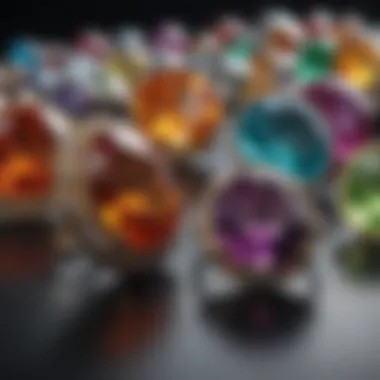
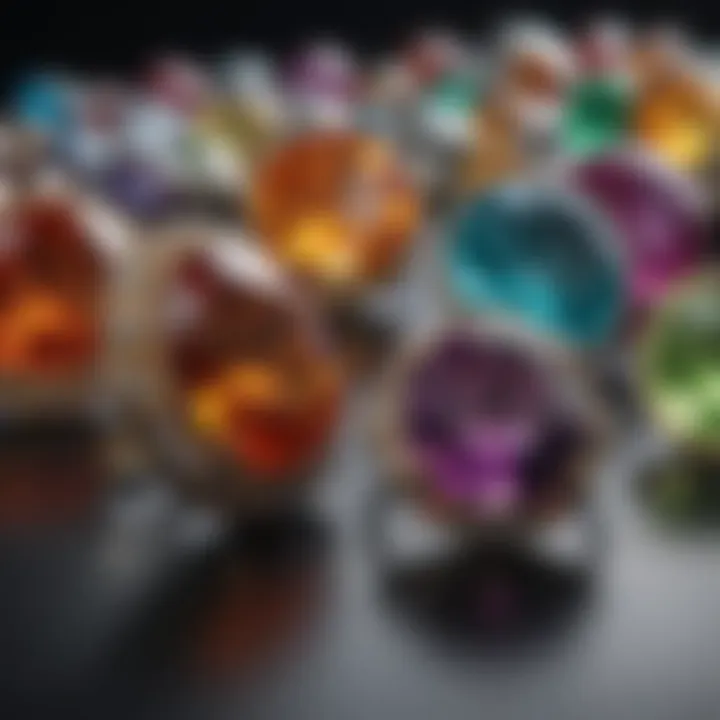
By training gemologists and providing various educational resources, GIA ensures a steady supply of knowledgeable professionals who can uphold their standards. Their mission is not just about grading gemstones; it encompasses the broader goal of fostering an environment where ethical practices prevail, and where consumers feel empowered in their purchasing decisions.
GIA's Certification Process
The certification process at GIA is a comprehensive evaluation of gemstones that involves multiple steps to ensure accuracy and reliability. The process includes precise measurements and analyses using advanced technology and techniques. Here's how it works:
- Initial Assessment: Once a gemstone is submitted, it undergoes a preliminary review that includes an inspection for any treatments or enhancements it may have received. This ensures that the final evaluation reflects the gem's natural state.
- Advanced Testing: Using sophisticated equipment, trained gemologists assess critical factors like cut, color, clarity, and carat weight. Each of these attributes is meticulously graded using GIA’s well-defined standards.
- Final Grading Report: Upon completion of analysis, a detailed report is generated. This report contains information about the gemstone’s characteristics and is accompanied by a grading scale that helps the buyer understand exactly what they are getting.
“A GIA grading report is more than a piece of paper; it’s a passport that adds value and trust to your gemstone.”
- Continuous Reevaluation: GIA remains committed to innovation and may reevaluate its grading processes designed to accommodate advances in gemology and shifts in market demands. This dynamic approach ensures that GIA remains at the cutting edge of gemstone evaluation, allowing buyers and sellers alike to navigate the market with clarity and confidence.
In short, GIA's certification process embodies transparency and professionalism, providing an essential service to all parties engaged in the gemstone marketplace.
Understanding the Four Cs
The Four Cs—carat, cut, color, and clarity—are the cornerstones of gemstone valuation. They provide a standardized way to assess the quality of a stone and hence its price. To put it simply, these factors act like the yardstick by which gems are measured. Before diving deep into each aspect, it's crucial to acknowledge their interconnectedness. Just as a jigsaw puzzle comes together to form a complete picture, these elements collaborate to give the buyer a clearer understanding of what they are purchasing.
Carat weight contributes heavily to a gemstone’s value; it essentially tells us how large the stone is. Next, we have the cut quality, which determines how well a stone reflects light and contributes to its brilliance. Color grading plays a key role, especially in colored stones, as the hue, saturation, and shade significantly influence desirability. Finally, clarity evaluates the presence of flaws, which can affect both aesthetic appeal and price. As a buyer or collector, understanding these Four Cs allows for more informed decisions, ultimately leading to better investments and satisfaction with your acquisitions.
Carat Weight's Influence on Price
In the gemstone world, carat weight is akin to a heavyweight title. The more carats, the heftier the price tag. This isn't just about size; it also ties back to rarity. Larger stones are far less common than smaller ones, which creates demand. For instance, a one-carat diamond may fetch a decent sum, but a four-carat diamond can balloon in price—sometimes exponentially!
Moreover, considering carat weight isn’t black and white. Two diamonds of equal carat can vary dramatically in price depending on their cut, color, and clarity. Thus, while carat weight is essential, it should not stand alone in the consideration of the gemstone's overall value.
"Larger doesn’t always mean better. You have to look at the complete package."
The Impact of Cut Quality
Cut quality is about how well the gemstone has been shaped and polished. A stone can have the highest carat weight or exquisite color, but if it's poorly cut, its value will plunge. The cut affects how light enters and exits the gem, impacting its brilliance and fire. For example, an ideal cut diamond gleams with a sparkle, reflecting light beautifully, while a poorly cut diamond may appear dull and lifeless.
Different cuts also appeal to different tastes. A round brilliant cut may be the classic choice, but someone might prefer the unique shape of an emerald cut. Moreover, expert cutters can optimize the gem's unique qualities, so paying attention to cut quality is paramount. This means a well-cut smaller stone can sometimes outshine a larger, but poorly cut one.
Color Grading and Its Significance
Color dictates the allure of colored gemstones. It's a crucial aspect of valuation. Each stone is graded on three primary factors: hue, tone, and saturation. For instance, a vivid blue sapphire is far more desirable than a pale one, which likely sees a dip in its market value.
In diamonds, the absence of color is considered ideal. Color grades range from D (colorless) to Z (light yellow). A diamond rated D is notoriously scarce and can demand a hefty premium. Thus, understanding color grading allows buyers to differentiate between stones that may appear similar on the surface but have starkly different values.
Clarity and Its Role in Valuation
Clarity refers to the presence of internal or external flaws, commonly known as inclusions and blemishes. A stone with higher clarity, which is less included, fetches a higher price than one with noticeable imperfections. When assessing clarity, jewelers typically use a 10x magnification to identify any flaws very closely. Some inclusions are so minor that they’re almost invisible to the naked eye, while others can drastically lower a gem's value.
Interestingly, some buyers prefer gemstones with unique inclusions as they add character and story to the piece. However, the general consensus remains clear: higher clarity generally means higher value. Understanding clarity helps buyers weigh these factors, ensuring they know what they're getting for their money.
By exploring these Four Cs in depth, individuals gain insightful perspectives on how gemstone values are determined. This understanding fortifies your ability to make savvy purchasing decisions within the vibrant gemstone market.
Market Trends Affecting GIA Prices
Understanding market trends is crucial for anyone navigating the gemstone valuation landscape. Gemstones aren't just pretty trinkets; they represent an intricate dance of supply, demand, cultural significance, and economic conditions—all of which play a significant role in determining their price through the GIA framework.
Trends in the market can shift quicker than a chameleon on a rainbow. Knowing what's hot—or not—enables buyers, sellers, and collectors alike to make informed decisions.
Current Trends in Gemstone Valuation
In recent years, the world of gemstones has witnessed several currents reshaping the landscape. For instance, the rise of sustainability plays a big part. More consumers are now eager to know where their gemstones come from. A gem's environmental impact can affect its allure, with ethically sourced stones often carrying a premium price tag. This shift toward responsible purchasing not only promotes sustainability but also emphasizes transparency in the supply chain.
Another notable trend is the increasing use of technology in gemstone grading and valuation. Platforms that leverage artificial intelligence are streamlining the grading process, making it more accessible. As these tools become commonplace, they can standardize evaluations and possibly alter price benchmarks.
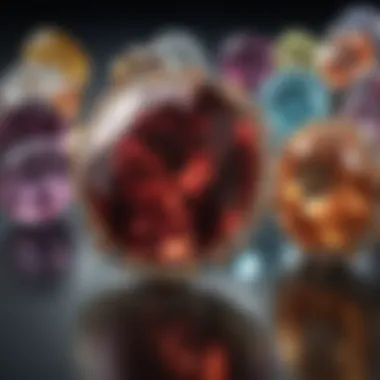
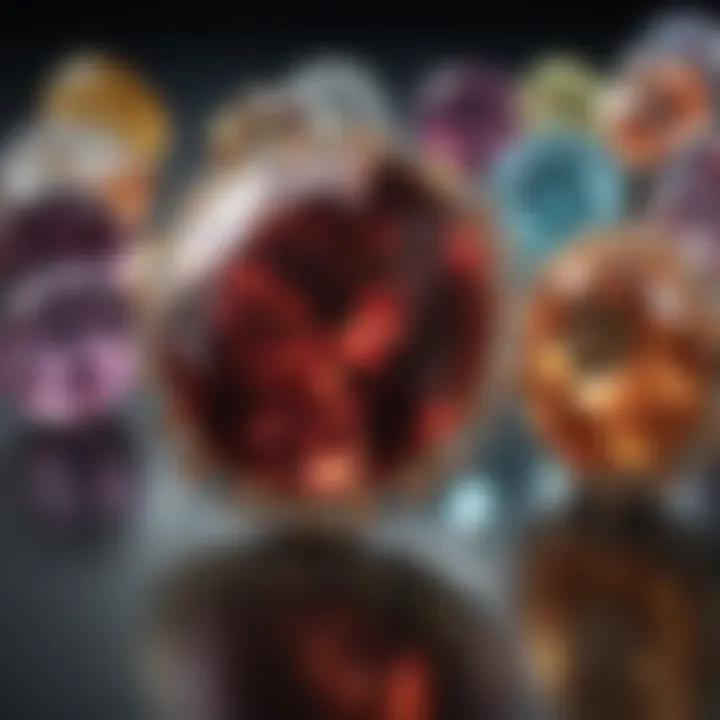
Emerging markets have also entered the fray. Countries in Asia, particularly India and China, are not only recognizing the importance of gemstones but are also ramping up their buying power. This enlarges the audience for high-quality stones and can temporarily spike prices as demand surges.
"Market conditions are like shifting sands; you need to know where to place your feet to avoid a fall."
Seasonal Fluctuations in Demand
Much like the changing seasons, demand for certain gemstones can fluctuate throughout the year. Specific occasions, holidays, or events tend to create peaks in consumer interest. For example, the diamond market sees a consistent spike around engagement season, leading up to Valentine's Day and, subsequently, high wedding months. During these periods, prices may skyrocket due to intense buyer competition.
On the other hand, some stones, like opals and emeralds, might enjoy heightened interest during certain seasons when their unique colors resonate more with buyers, influenced by fashion trends or seasonal styles.
The aggregate impact of these seasonal demands creates a rhythm in the marketplace. Therefore, understanding when and how demand shifts can empower collectors and investors, giving them insights into potential buying opportunities or price brackets. Being savvy about these patterns can mean the difference between snagging a great deal and overpaying due to blind impulse buying.
Rarity and Its Effect on Pricing
Rarity is a significant player in the game of gemstone pricing. In the market, not all gemstones are created equal. Some are more common, while others are scarce. This scarcity introduces a unique dynamic to pricing. When we talk about gemstones, rarity can swing the pendulum of value dramatically, influencing both collectors and casual buyers. Understanding how rarity intertwines with market patterns and consumer demand can help you make informed decisions.
Gemstones like diamonds are everywhere, but there are rarer stones, too, such as painite or red beryl, which simply aren't as accessible. Rare gemstones often carry a higher price tag, not just due to limited availability, but also because of the stories, mystique, and heritage associated with them. Buyers are willing to pay a premium for that uniqueness—this makes it essential to grasp the relevance of rarity when approaching pricing.
Recognizing Rare Gemstone Types
To appreciate how rarity affects pricing, one must first recognize which gemstones are considered rare. It's not always about diamonds or rubies.
- Painite: Once considered the rarest mineral on earth. This brownish-red stone was almost mythological until recent finds. Though now a bit more available, it's still incredibly scarce.
- Red Beryl: This strikingly vivid stone only forms under very specific conditions in a limited area. Its radiance and uniqueness propel its desirability, often fetching remarkable prices.
- Alexandrite: Exhibiting a fascinating color change from green to red, this gemstone’s limited sources make it one of the most sought after.
Identifying these types of gemstones can be a valuable skill for anyone in the market. A rare gemstone often signifies a higher investment, carrying with it a tale of creation and journey. Buyers often lean towards pieces that stand out, both in appearance and backstory. Understanding these nuances not only nourishes your appreciation for gemstones but also aligns your purchasing strategy with market demands.
Market Scarcity and Increased Value
When considering the broader impact of rarity, market scarcity naturally comes into play. Scarcity doesn't just mean low quantities; it also encapsulates the difficulty of obtaining certain gemstones. When a gem is hard to find, collectors and enthusiasts may scramble to secure it, driving up its value.
- Supply and Demand Dynamics: Basic economics dictates that when demand exceeds supply, prices soar. This is particularly evident in auctions where eager bidders fight over a singular rare gemstone. The competitive atmosphere often elevates prices dramatically.
- Investment Potential: Rare gemstones can often act like tangible assets, holding value, or even appreciating over time. Collectors who invest in these stones can find themselves in a lucrative market, should they decide to sell later.
"Understanding the rarity within gemstones allows consumers to navigate their purchases with acuity and foresight."
- Consumer Psychology: The allure of owning something few possess can push buyers toward higher price points. This psychological factor is not trivial; it plays a pivotal role in purchasing decisions, especially amongst collectors who value exclusivity.
Consumer Behavior in the Gemstone Market
Understanding consumer behavior in the gemstone market is vital, as it reveals the underlying motivations that drive purchases. In a world where emotional and financial investments collide, the decisions made by buyers can ripple through the entire gemstone industry. As trends shift and values fluctuate, knowing what informs buyer preferences can guide sellers, collectors, and designers to navigate this complex landscape. The gemstone market isn’t just about shiny objects; it's about the stories they tell and the significance they embody for those who choose to wear or collect them.
Understanding Buyer Preferences
Buyer preferences often hinge on several factors ranging from aesthetic appeal to personal significance. Many consumers are drawn to gemstones that resonate with their identity or values. For instance, individuals may seek out ethically sourced stones that align with their commitment to sustainability. Others might prefer gemstones with specific colors that reflect their personality or life events. Additionally, trends such as the popularity of unique cuts or alternative gemstones often influence choices, creating a dynamic market where classic styles co-exist with bold new trends.
The Gemological Institute of America's role in providing reliable information about gemstones enhances buyer confidence. When a customer understands the quality and provenance of a gemstone, they are more inclined to make a purchase. Knowledge becomes power, especially in a market where authenticity is paramount.
The Influence of Social Media on Purchases
Social media plays a pivotal role in shaping buyer behavior in today’s gemstone market. Platforms like Instagram and Pinterest host a visual feast, allowing users to explore stunning jewelry designs and gemstone variations at the swipe of a finger. These platforms not only help potential buyers discover new trends but also provide a space for them to share their finds and preferences with their peers. The power of visual storytelling makes it easier for brands to captivate an audience.
Moreover, the influence of online reviews and influencer recommendations cannot be understated. A single post by a trusted influencer can boost the desirability of a specific gemstone or design. Recommendations from trusted figures become a part of everyday consumer decisions, often leading to increased sales.
Buying decisions are now intertwined with online interactions. The seamless blend of social proof and visual allure keeps buyers engaged, often leading to impulsive purchases influenced by fleeting trends. This highlights the importance of digital marketing strategies for sellers in the gemstone market.
"Understanding consumer preferences is not just an exercise in data gathering; it's about connecting with stories and experiences that search for tangible expressions in gemstones."
In short, consumer behavior in the gemstone market goes beyond mere transactions. It's a reflection of values, trends, and the emotional connections individuals form with gems. Sellers who tune into these nuances can forge deeper relationships with buyers, leading to loyalty and enhanced sales.
Practical Implications for Buyers
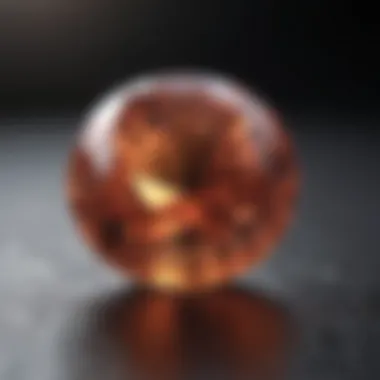

In the intricate world of gemstone valuation, understanding the GIA pricing framework provides a solid footing for both novice and seasoned buyers alike. When engaging in the gemstone market, it's vital to grasp not only the pricing mechanisms but also how they influence various buying decisions. Knowledge about the nuances of GIA pricing empowers buyers, ensuring they make informed choices that align with their preferences and budgets.
For buyers, navigating through the noise of flashy advertisements and enticing sales pitches can be a daunting task. Being aware of the four Cs—carat, cut, color, and clarity—offers clarity in evaluating gemstones beyond their aesthetic appeal. When you can critically assess these attributes, you are less likely to fall prey to inflated prices or subpar quality.
This insight serves to not only bolster buyer confidence but can also translate into better negotiations with sellers. It's crucial to remember that being an informed buyer doesn’t just make you feel good; it could also save you a significant amount of money.
Tips for Assessing Value
When it comes to assessing a gemstone's value, a meticulous approach is key. Here are crucial tips to guide you:
- Research the Gemstone: Understand the specific attributes of the gemstone in question. Some stones have inherent value due to their rarity or cultural significance. For instance, a pink diamond often carries more value compared to a traditional white diamond of the same carat weight.
- Check GIA Certification: Always ask for a GIA certification before making a purchase. This document serves as a trustworthy record of the stone's grading and can provide you with peace of mind.
- Compare Prices: Don't settle on the first offer you receive. Taking the time to compare prices from different sources, both online and local shops, can unveil significant differences that allow for better decision-making.
- Scrutinize the Four Cs: Examine each of the four Cs closely. For example, a stone with a higher clarity grade but a lower carat weight might present a better value than a larger, included stone.
By following these steps, buyers can establish a comprehensive understanding of value, which is critical, especially in a market that often seems overwhelming.
Negotiate and Transparent Pricing
Once you’ve gotten a grasp on how to assess value effectively, the next step involves navigating negotiations. Transparency in pricing is paramount, both for gaining trust and for achieving a satisfactory transaction.
- Start with Open Questions: Approach the seller with open-ended questions regarding price. Inquire about how the price was determined and what factors influenced it. A seller willing to discuss these elements is often more credible.
- Be Polite but Firm: When negotiating, a polite demeanor often yields better results. However, don't hesitate to stand your ground if you believe the price doesn't reflect the assessed value. politeness can go a long way.
- Know When to Walk Away: Understanding your limits is essential. If negotiation leads to experiences where the pricing remains opaque, or if the seller seems unwilling to budge, mentally preparing to walk away can sometimes yield better offers down the line.
In essence, mastering the art of negotiation not only equips buyers with the tools necessary to ensure fair pricing but can also create a healthier marketplace in terms of buyer-seller relationships. Armed with knowledge and negotiation tactics, gemstone lovers can dive into the market with a sense of empowerment and clarity.
"Being informed is being empowered. When it comes to gemstones, it’s your best tool."
This understanding of buyer dynamics contributes significantly to one’s overall experience in the gemstone market, encouraging them to make prudent decisions that resonate with their needs.
End
In wrapping up the exploration of GIA pricing, it’s essential to recognize how intertwined various factors are in gemstone valuation. The GIA’s rigorous standards and methodologies—spanning the Four Cs, market nuances, rarity, and consumer behavior—form a cohesive framework that aids buyers in making informed decisions.
A key takeaway is the understanding that pricing isn’t merely a number; it reflects a world of quality and craftsmanship. Gemstone enthusiasts, collectors, and designers benefit significantly from grasping how each element plays a role in valuations. The Four Cs, for example, are not isolated traits but rather come together to create a comprehensive picture of a gem's worth. Appreciating how these characteristics interplay can lead one to spot gems that are truly treasures versus those simply marketed as such.
Furthermore, as market trends evolve, keeping an eye on shifts in consumer preferences and technological advancements—such as how social media influences purchasing decisions—becomes increasingly vital. Economic fluctuations can affect demand and rarity, underscoring the need for buyers to remain vigilant and adaptive.
Here’s a concise recap of vital points:
- Understand the Four Cs: Carat, cut, color, and clarity aren’t just technical terms; they are fundamental to appreciating a gemstone’s value.
- Market Awareness: Recognizing seasonal trends and current consumer interests can lead to better investments.
- Rarity Matters: Knowledge about scarce gems and their market implications can set you apart in the collector’s scene.
Ultimately, the importance of comprehending GIA pricing transcends basic knowledge. It empowers individuals to approach gemstone purchases with a discerning eye and clear expectations. With this newfound clarity, buyers can not only enhance their collections, but stand as informed advocates in a vibrant marketplace.
"In the world of gemstones, knowledge is not just power; it’s a tool for smarter investments and true appreciation.”
Navigating the intricate web of gemstone valuation through GIA's lens fosters a deeper respect and understanding for these remarkable natural creations. Thus, embarking on this journey not only elevates one’s purchasing acumen but enriches the overall experience of collecting and designing with gemstones.
Further Reading and Resources
Understanding the nuances in gemstone valuation requires ongoing education and engagement with updated resources. This section highlights the importance of additional reading and materials to deepen knowledge about GIA pricing and the gemstone market. Readers can gain insights that complement the information shared in this article, ensuring a well-rounded perspective.
Importance of Further Reading
- Staying Informed: The gemstone market is dynamic, influenced by evolving trends and buyer behavior. Regular reading helps gemstone enthusiasts, collectors, jewelry designers, and geology fans stay attuned to the latest developments. Whether it’s market fluctuations or changes in pricing strategies, being informed can make a major difference in decision-making.
- Understanding Complexities: Gemstone valuation isn’t just a flat figure. Each stone carries its own story, depending on various factors. The four Cs are foundational, yes, but digging deeper into the nuances of these elements through articles and academic papers can illuminate complex relationships and valuation criteria.
- Diverse Sources: While this article offers a comprehensive overview, supplementary material allows readers to approach the topic from different angles. Books, journals, and reputable online sources can provide diverse context on GIA’s role, market analysis, and consumer psychology.
- Practical Guides: Many resources offer practical tips and guides on how to assess gemstones. This is particularly beneficial for buyers who want to put their knowledge into action. Guidance on what to look for in a certification or tips on negotiating prices can empower consumers.
Recommended Resources
Here are some suggested resources that can enhance understanding of gemstone valuation and GIA pricing:
- GIA Website: The Gemological Institute of America’s site provides a wealth of information about their grading system, certification, and educational materials relevant to gemstones. GIA Education
- Wikipedia: A great starting point for a broad overview of gemstones and basic valuation concepts. It can also link to articles that delve deeper into specific stones or valuation methods. Wikipedia Gemstones
- Britannica: This platform offers well-researched articles on gemstones, their properties, and history. It can give extra context to what makes certain gemstones particularly valuable. Britannica on Gemstones
Forums and Community Discussions
Engaging with the community can also provide practical insights. Websites like Reddit and Facebook have groups where enthusiasts and experts share experiences, ask questions, and give advice on gemstones.
- Reddit: Explore various subreddits dedicated to gemstones and jewelry where members discuss their experiences, valuation, and even share tips for buyers. Reddit Gemstone Page
- Facebook: Join groups that focus on gemstone knowledge. These groups often share real-time market updates, news about gemstone origins, and tips from fellow members. Facebook Groups on Gemstones
"In the gemstone world, knowledge is not just power; it's your guiding light in a complex marketplace."



